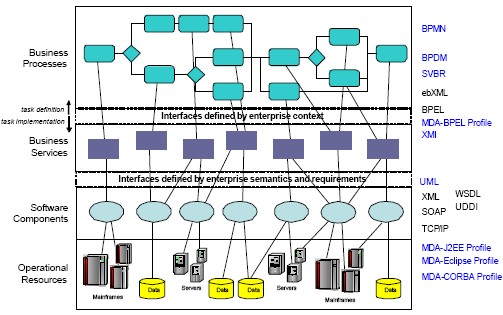Today started off with a panel called What the Business Needs: Standards and Technology for BPM Success. Derek Miers moderated, and the panelists were Joe Olsey of Morgan Stanley, Greg Meyer of iJET (who gave a keynote yesterday), Nancy Draft of Volvo (who will be giving a keynote following the panel) and Bruce Silver.
Miers started with a question to the panelists on the value of standards to the business, which ranged from modelling to technology standands. Responses across the board included that a shared understanding of a process is a big reason for modelling standardization, and technology standards such as those used within web services help to create a more agile development and deployment environment.
[Eek! I just heard the phrase “service orientated architecture” from one of the panelists! I may be just an engineer, but I roomed with an English major at university and some misuses of language really grate on me.]
An audience member jumped in and said that there is also a benefit to standards when organizations merge: if everyone is using standards for modelling, serialization and implementation, it makes is a lot easier to put systems together down the line.
The XPDL and BPDM smackdown started with some comments from Silver, which he also discussed in his blog yesterday. He quoted Keith Swenson from the WfMC XPDL technical committee as saying “The BPDM metamodel and BPMN schema are available today. It’s called XPDL.”, then added his own comment: “That’s basically true. OMG has effectively given XPDL a two-year window to establish itself as the de facto BPMN schema, and make the official OMG epic irrelevant.” I think that the XPDL/BPDM war is going to be a long and messy one.
Meyer stated that he sees very little benefit to businesses in being early adopters of standards: it’s a lot of work; it will probably change at least once before everyone else adopts it, requiring significant rework; your trading partners will likely to slower to adopt, hence the creation of externally-facing standardized interfaces won’t be used for the first several years; and when it does become mainstream, the cost of adoption will be significantly lower than for the early adopters. An audience member jumped in to say that standards have become part of the marketing war between vendors (with the big guys trying to discredit the smaller ones because they haven’t adoped the standards yet) rather than providing real benefit early on within customer organizations, and that there needs to be more control by the customer organizations. If you take a look at standards committees, many of them are heavily loaded with big vendors with their own interests in mind; there’s certainly a benefit for customer organizations to be involved at least at the requirements stage. Silver summed it up by stating that standards lead to commoditization of technology, which lowers price, but that doesn’t help the early adopters: really a restating of Meyer’s point. Although there was a call to arms for customer organizations to get more involved in standards, I’m not sure that’s the answer: there’s still going to be a long adoption curve for standards, with lots of extra costs for organizations that are early adopters before it becomes a commoditized part of every vendors’ offerings.
Jeanne Baker jumped in and asked the three panelists from customer organizations about their secrets to success with BPM, which led to a discussion about functional and organizational modelling, and how organizational modelling can lead to further enforcing the silos within an organization rather than breaking down the cross-silo boundaries that can occur with pure functional modelling. Not surprising, the need for a high-level champion came up — this true of pretty much any enterprise-wise implementation of technology that impacts the business users — and the process of evangelizing the implementation within the organization.
Olsey made some great points about the acceptance of standards, and how although we may not get any particular area down to one standard right away, having a small number of standards is better than no standards at all. The flip side of that is that vendors (and some customer organizations) will almost certainly need to implement multiple standards, but with luck there will be a small number of them and there will eventually be some convergence. Meyer said a major problem with the standards is that they’re too rich and cover too much ground, which means both a long time to develop and standardize the standards, and a long time to implement them. He issues a call for “just getting it done”, which echoes his earlier comments on the pain of being an early adopter of standards, as an end-user organization: if the standards are simpler, they will be adopted faster and will cost less to do so.
Silver blames the customer organizations for turning standards into just check boxes on an RFP, but I put that blame with the large analysts who write RFP templates used by customers, and by large vendors who implement the standard in some way, then push out the message that you must embrace that standard or a plague of locusts will fall upon you.
I haven’t done a post on the BPEL roundtable that I attended yesterday afternoon, or a Day 2 wrapup, so they’ll be out of chronological order relative to the conference but in the order that I actually write the posts (I don’t usually play with the times on my posts to insert something before an existing post since people who read this blog directly rather than through an RSS reader might miss them).

